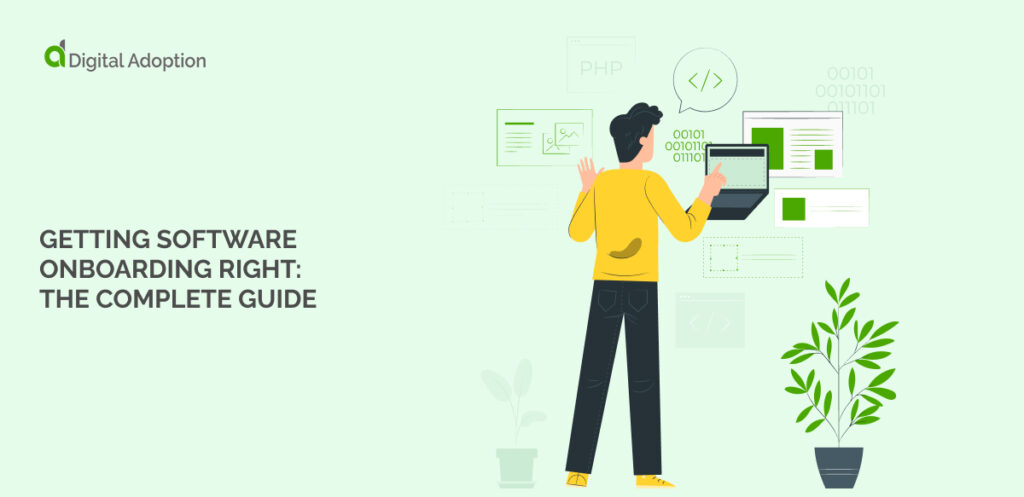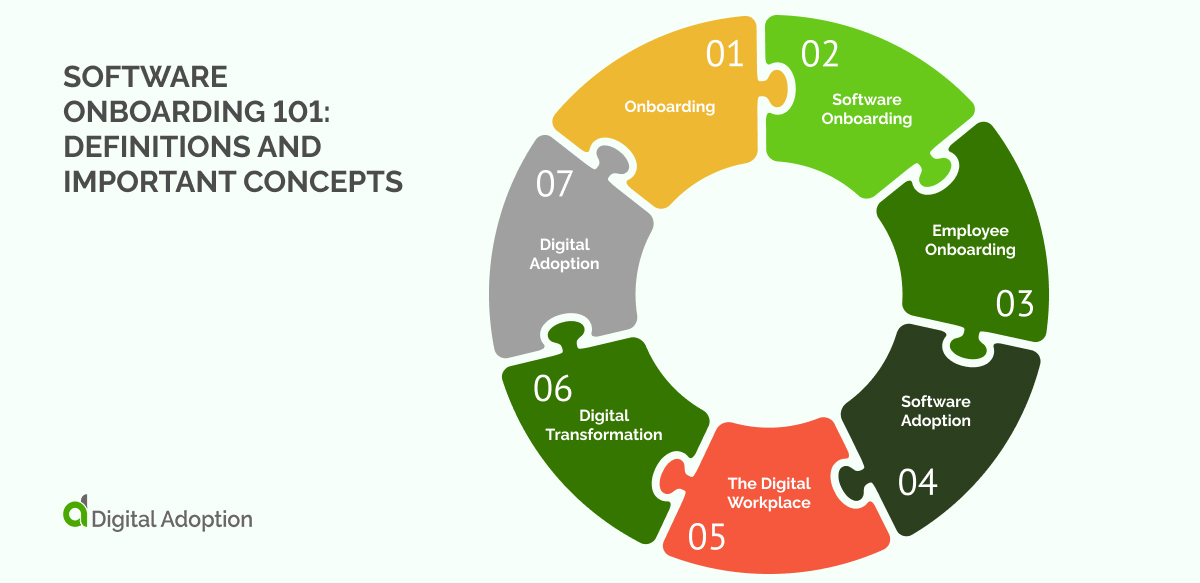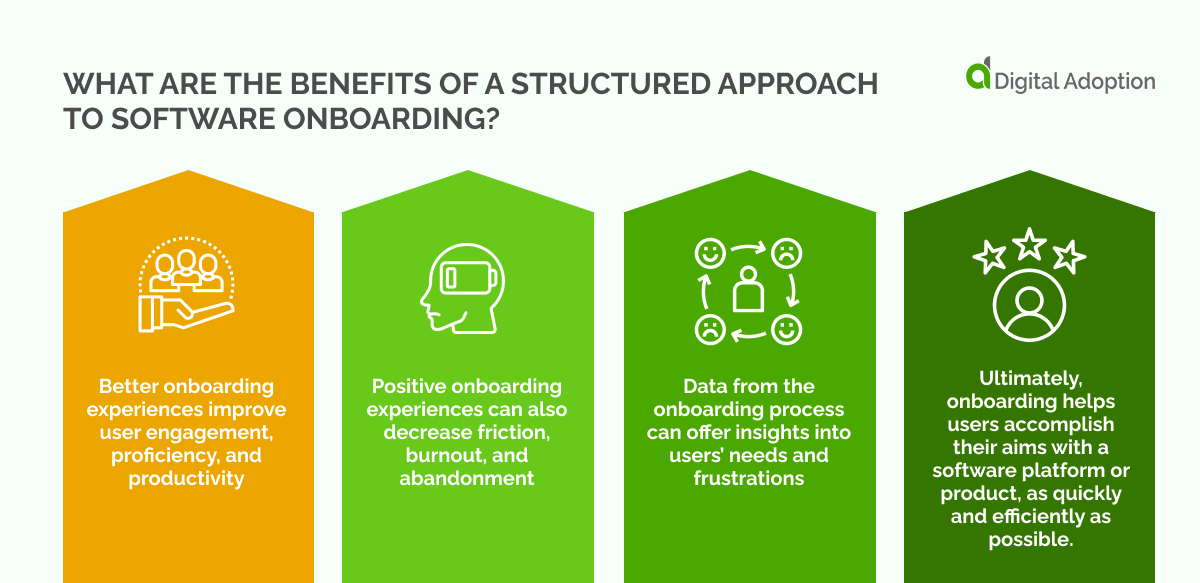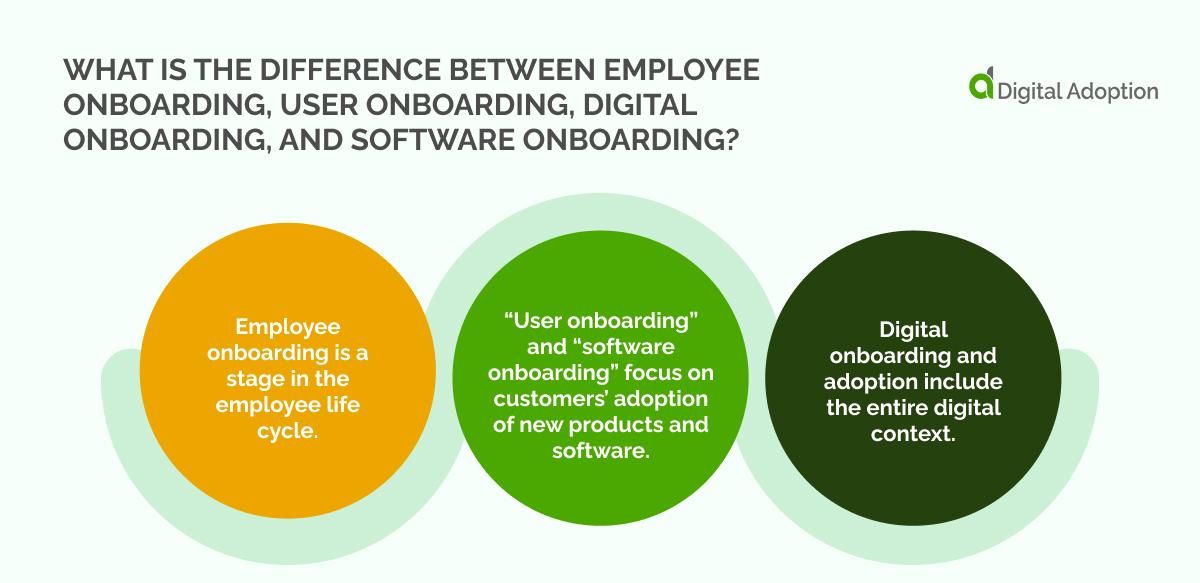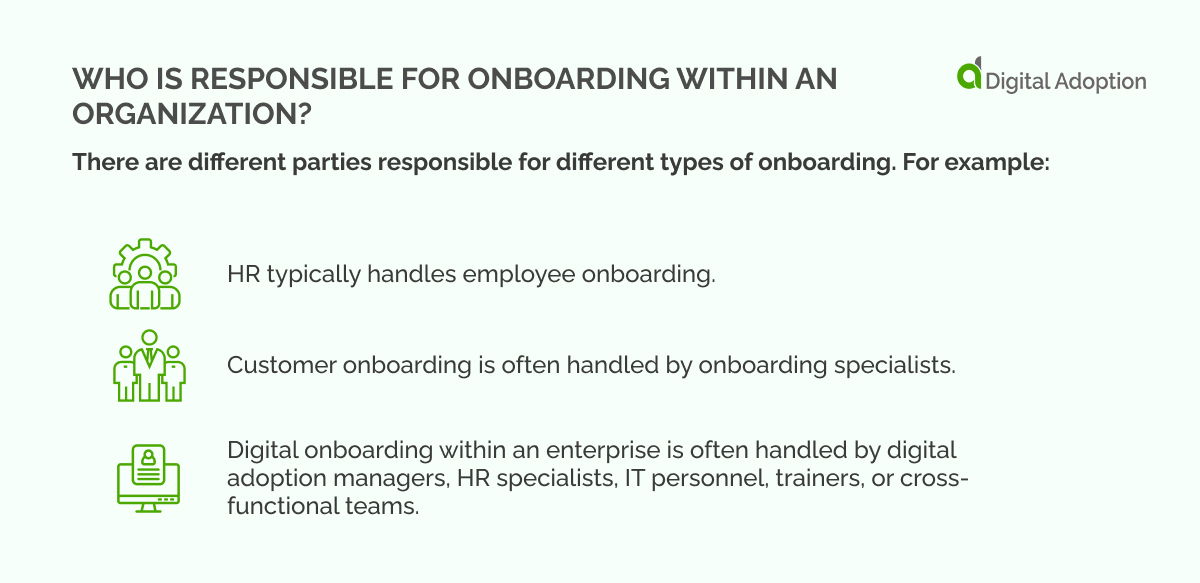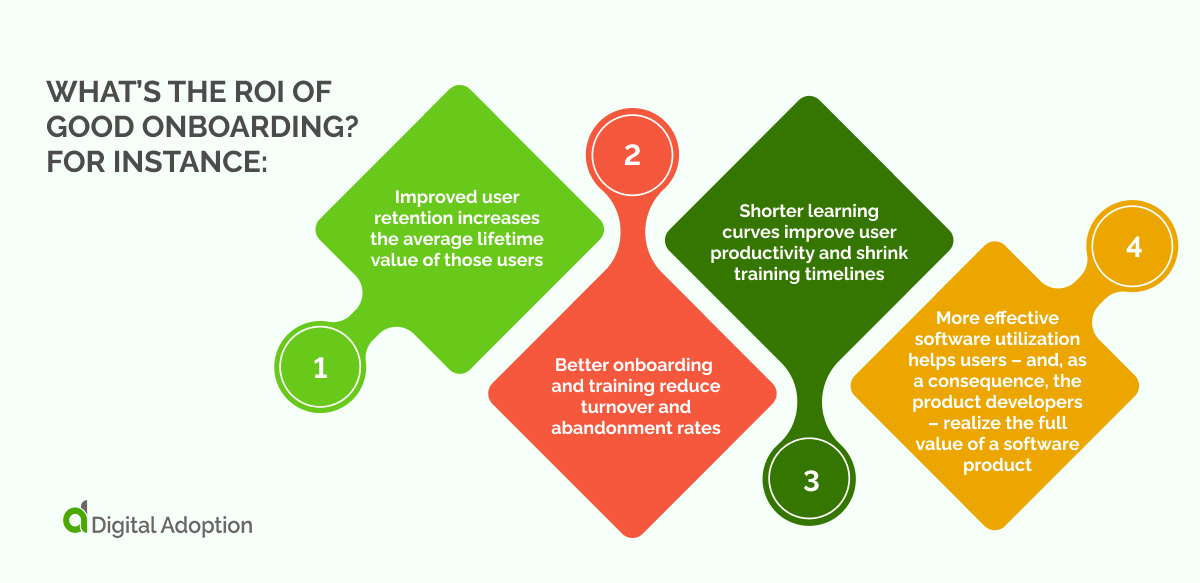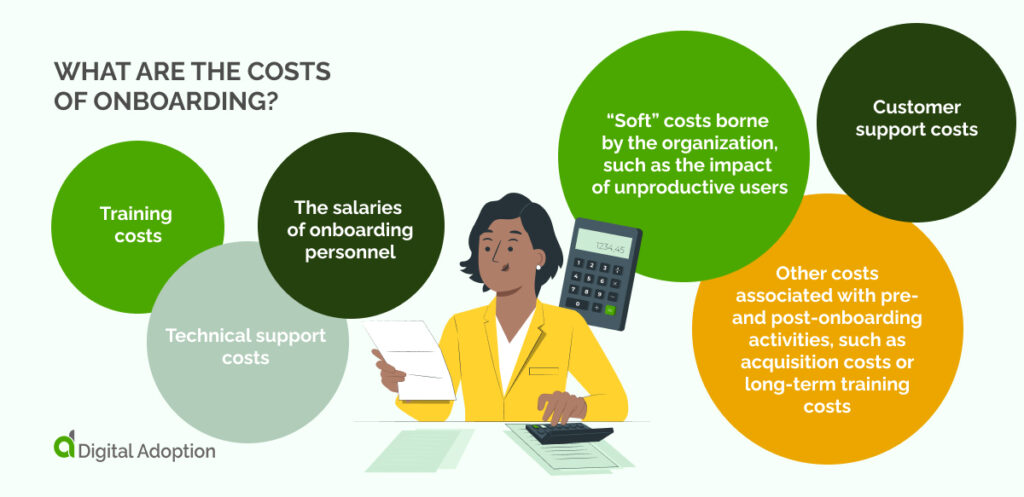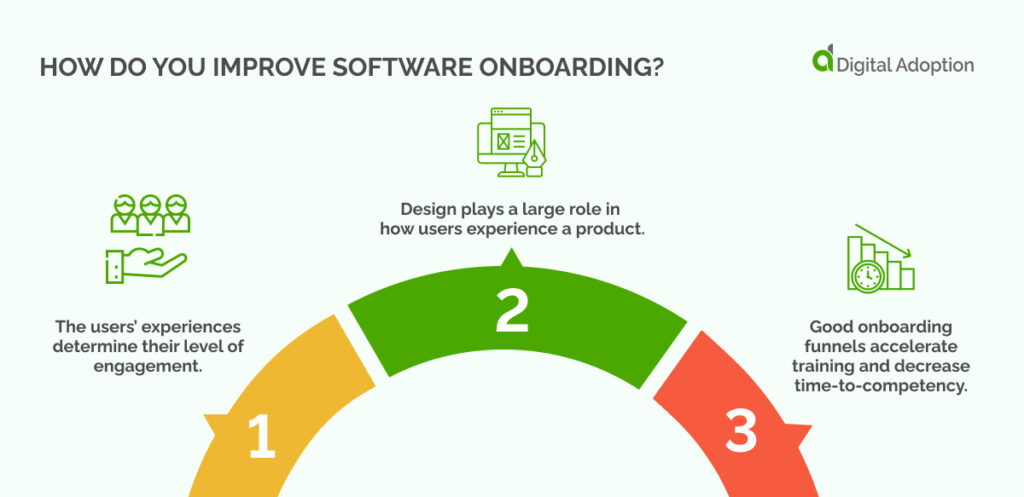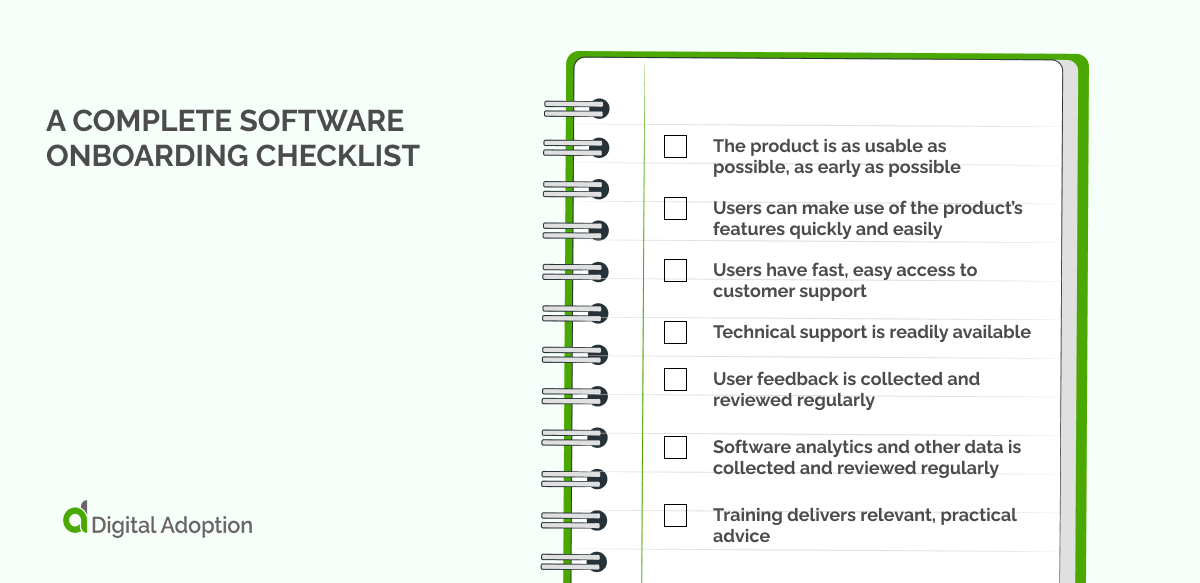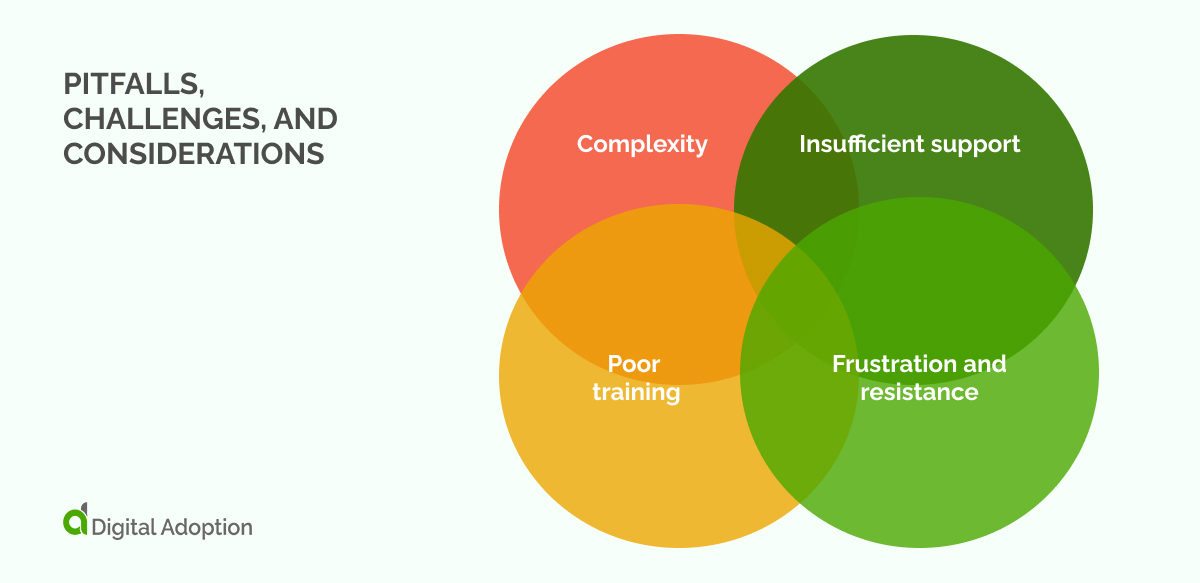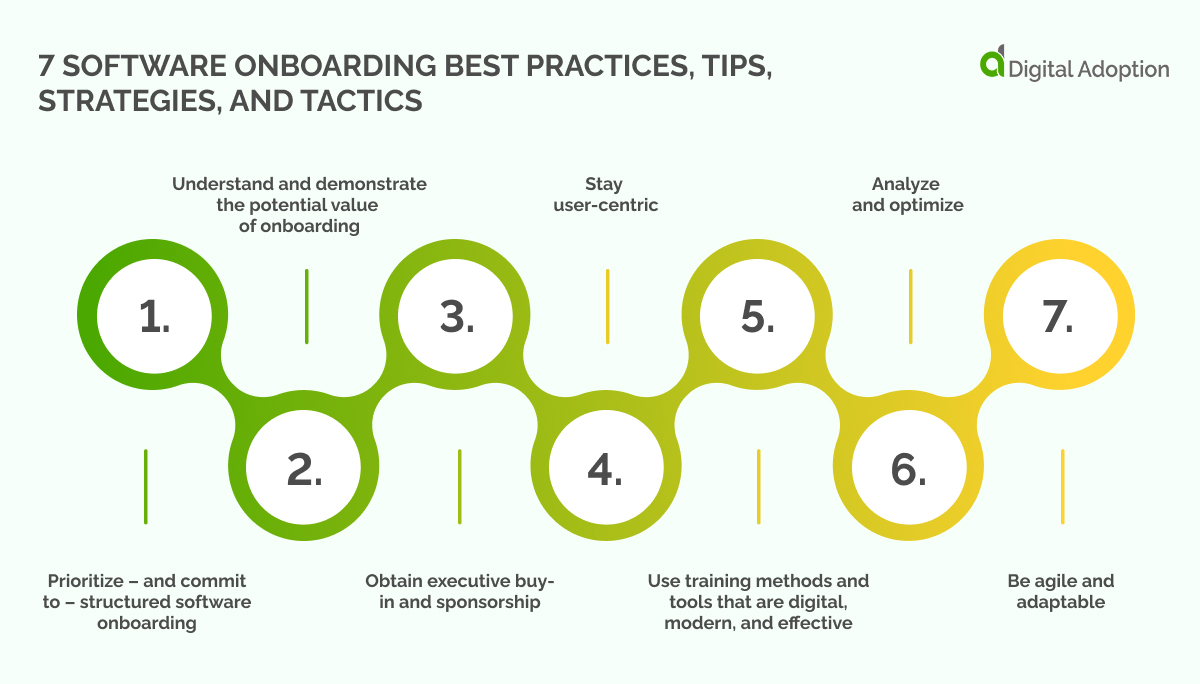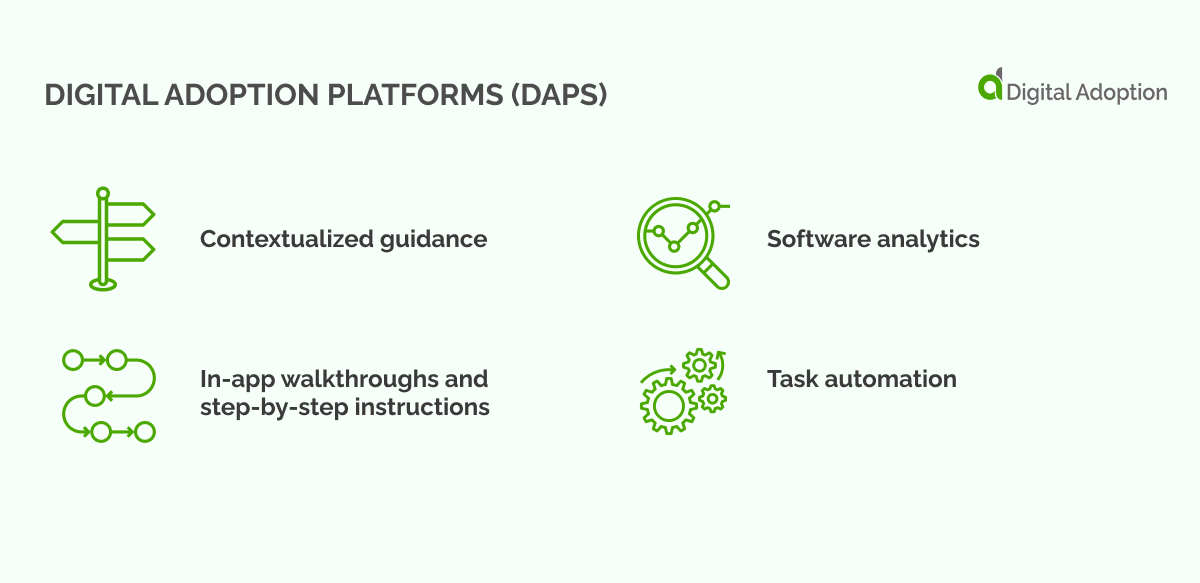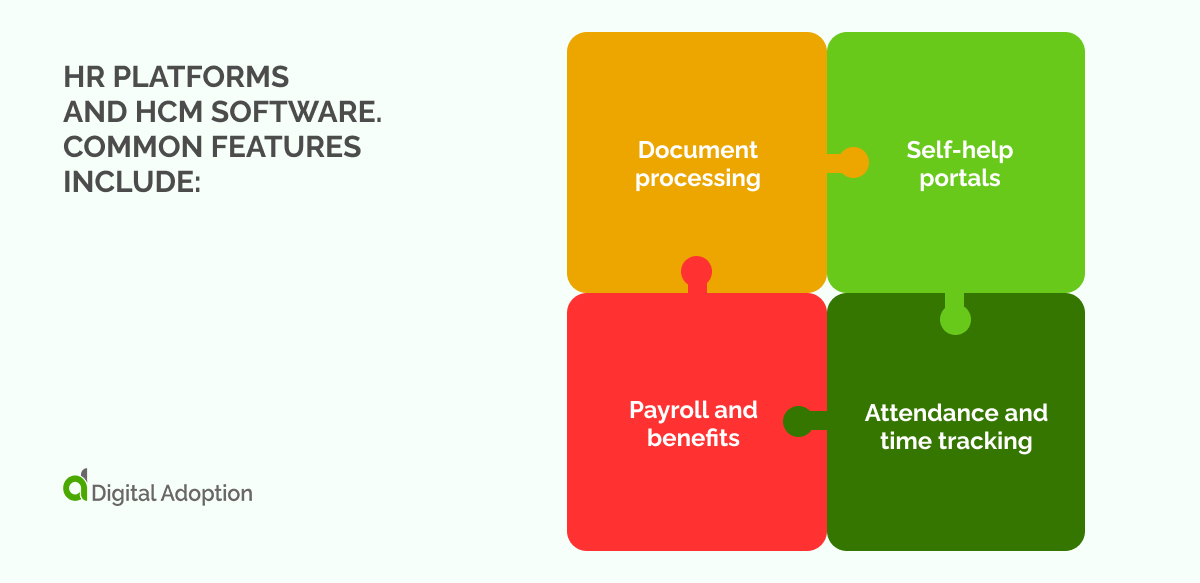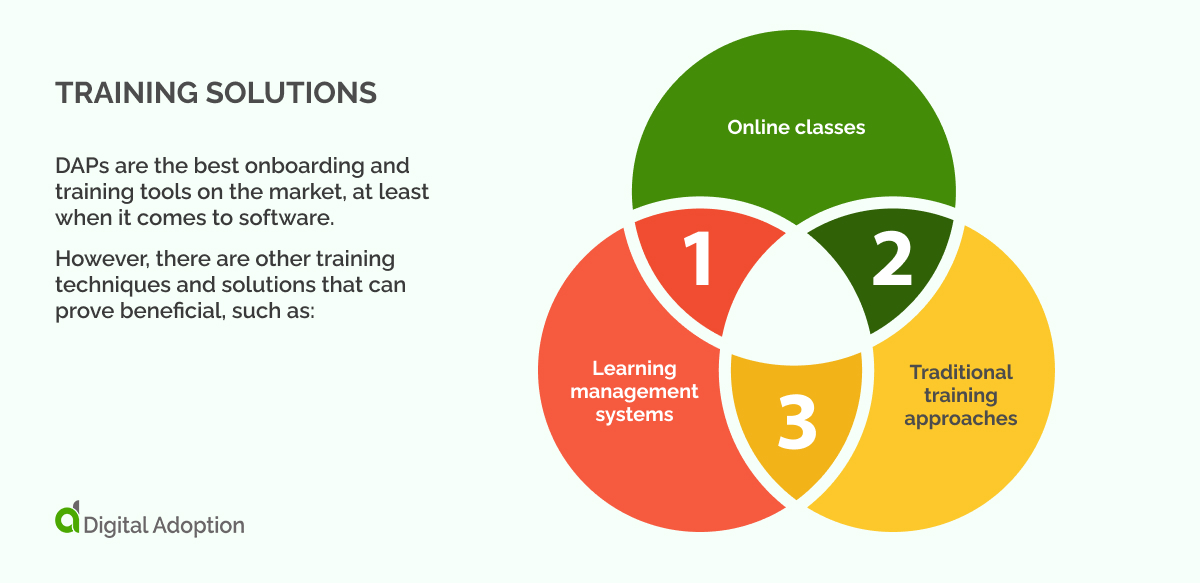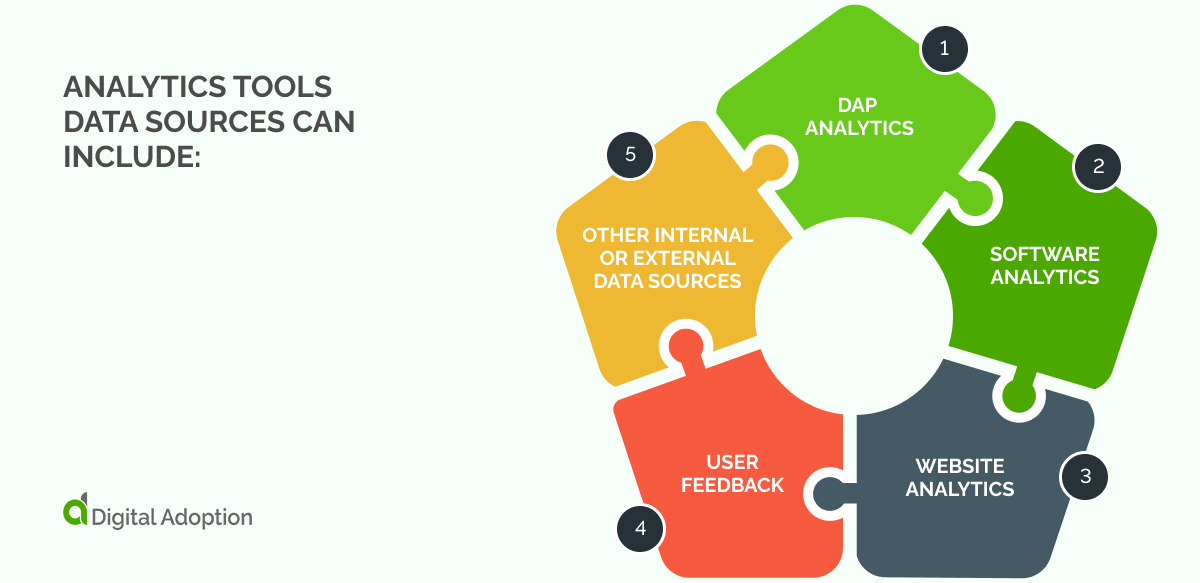Software onboarding is an important step in the software adoption process, when employees and customers form their first impression of a product.
Getting this stage right is critical, both for employers and software developers.
Below, we’ll learn how to get software onboarding right … and why onboarding matters so much.
Plus, we’ll look at:
- Software onboarding vs. software adoption
- Software adoption vs. digital adoption
- A software onboarding FAQ
- Best practices, tips, tricks, and strategies
- Top onboarding software
- The future of software onboarding
And much more.
To start with, let’s cover a few basic definitions and concepts.
Software Onboarding 101: Definitions and Important Concepts
Those new to software onboarding will need to learn the fundamentals of software onboarding – what it is and how it fits into the “big picture” of business.
These definitions will shed light on important processes related to software onboarding, including employee onboarding, software adoption, digital adoption, and the digital workplace:
- Onboarding – Onboarding is a general term that refers to the introduction and integration of a new person, product, or tool.
- Software Onboarding – Software onboarding is the process that occurs when new employees or users integrate software into their daily workflows.
- Employee Onboarding – Employee onboarding is an important part of the employee experience, when employees are introduced to and integrated into the workplace.
- Software Adoption – Software adoption is the overall process of implementing and integrating new software. This process includes onboarding.
- The Digital Workplace – The digital workplace refers to the digital component of a work environment, including the digital tools used, digital workflows, and so on.
- Digital Transformation – Digital transformation refers to digitally-driven organizational changes that leverage new technology to transform how a business operates and delivers value to its customers.
- Digital Adoption – Digital adoption takes software adoption one step further, focusing on streamlining the digital workplace and maximizing software ROI, utilization, efficiency, and productivity.
In today’s digital economy, digital transformation and adoption are the norm.
This need for continual digital evolution means that employees must continually adopt and learn new software programs.
In an ever-changing environment such as this, it is critical to have structured, efficient onboarding processes.
As we’ll soon discover, poorly structured onboarding – or not having an onboarding process at all – can have negative impacts on employee productivity, user engagement, and the ROI of a software platform.
Software Onboarding FAQ
Here are some of the most commonly asked questions about software onboarding:
What are the benefits of a structured approach to software onboarding?
There are many reasons why a business would want to structure and optimize their onboarding processes:
- Better onboarding experiences improve user engagement, proficiency, and productivity
- Positive onboarding experiences can also decrease friction, burnout, and abandonment
- Data from the onboarding process can offer insights into users’ needs and frustrations
Ultimately, onboarding helps users accomplish their aims with a software platform or product, as quickly and efficiently as possible.
This, in turn, helps businesses realize the full value and ROI from that software product.
What is the difference between employee onboarding, user onboarding, digital onboarding, and software onboarding?
Here is a quick summary of the differences:
- Employee onboarding is a stage in the employee life cycle. HR views “employee onboarding” as one phase of the employee’s journey with an organization. During this stage, employees integrate into the work environment. Software onboarding is one important aspect of employee onboarding, but not the only one.
- “User onboarding” and “software onboarding” focus on customers’ adoption of new products and software. Product developers, such as SaaS platform companies, pay close attention to new user acquisition and adoption. In many cases, user onboarding and software onboarding refer to customer onboarding. Oftentimes these terms are used interchangeably, along with terms such as “product onboarding.”
- Digital onboarding and adoption include the entire digital context. The digital workplace employees multiple digital tools and workflows. When employees are hired into these complex digital work environments, they must not simply adopt a new tool – the must adopt an entire set of digital tools, skills, and workflows.
Though the nuances and contexts differ, there is clearly a great deal of overlap between these processes.
And in many cases, they refer to the same thing.
User onboarding, software onboarding, and product onboarding, for instance, are usually used by product developers who are discussing their customer onboarding processes.
Who is responsible for onboarding within an organization?
There are different parties responsible for different types of onboarding.
For example:
- HR typically handles employee onboarding. Employee onboarding, as mentioned, is a phase in the employee life cycle. It involves a number of new hire activities, including orientation, social integration with coworkers, digital onboarding, and more.
- Customer onboarding is often handled by onboarding specialists. Product developers often hire onboarding specialists who focus exclusively on new customer onboarding. Their aim is to streamline the adoption of their product, decrease user abandonment, improve engagement, and ultimately enhance the product’s performance in the marketplace.
- Digital onboarding within an enterprise is often handled by digital adoption managers, HR specialists, IT personnel, trainers, or cross-functional teams. Businesses also need to streamline the internal adoption of new technology. After all, the ROI of their software investments depends a great deal on the effectiveness of their onboarding and digital adoption efforts.
Below, we will examine the differences between these terms – and why it matters – in more detail.
What’s the ROI of good onboarding?
Naturally, the ROI of onboarding will differ depending on the context, how effectively the onboarding program is executed, the product’s design, and other factors.
However, when done correctly, the positive outcomes of onboarding efforts echo the benefits covered above.
For instance:
- Improved user retention increases the average lifetime value of those users
- Better onboarding and training reduce turnover and abandonment rates
- Shorter learning curves improve user productivity and shrink training timelines
- More effective software utilization helps users – and, as a consequence, the product developers – realize the full value of a software product
Structured onboarding, in short, helps enhance the users’ initial experience with a product or solution, improving a wide variety of user metrics.
When those end users are the customers of a product development company, this translates into better marketplace performance and better bottom-line profits.
And if those users are employees at a company adopting new software solutions, the same holds true. Employees who are more productive and proficient will help the business realize the full value of its software investment, in less time.
What are the costs of onboarding?
Onboarding, like any other business process, costs time and money.
And because poor onboarding only increases those costs – through poor results, high turnover, user abandonment, and so forth – it pays to understand the costs of onboarding.
Any onboarding program comes with typical overhead, such as:
- The salaries of onboarding personnel
- Training costs
- Technical support costs
- Customer support costs
- “Soft” costs borne by the organization, such as the impact of unproductive users
- Other costs associated with pre- and post-onboarding activities, such as acquisition costs or long-term training costs
Poor onboarding experiences only compound these costs.
For instance, imagine that a SaaS developer’s poor onboarding process causes an increase in user abandonment. To compensate, the organization would be forced to pour money into other stages of the user journey, such as user acquisition or customer support.
Likewise, if a business adopted new software for internal use, poor onboarding processes would negatively impact employee productivity.
And those lower skill levels would negatively affect the organization as a whole, decreasing efficiency and productivity for the entire business.
How do you improve software onboarding?
Software onboarding should be built around the user experience.
That is:
- The users’ experiences determine their level of engagement. Software engagement levels directly affect how effectively people learn, how motivated they are, and how satisfied they are with a product. If users are disengaged, their proficiency levels will likely stagnate … if they don’t abandon the product altogether.
- Design plays a large role in how users experience a product. Well-designed onboarding experiences build off of product design. Good onboarding funnels introduce features quickly and effectively, helping users achieve their aims as efficiently as possible.
- Good onboarding funnels accelerate training and decrease time-to-competency. The faster users can achieve their goals and realize value, the better the outcomes will be. Users who have difficulty understanding a product or becoming productive, however, will be more likely to abandon the product.
There is no one-size-fits-all approach to onboarding, since each product is unique.
However, by staying focused on the end user’s experience, it is hard to go wrong.
Below, we’ll look at a software onboarding checklist built specifically around a user-centered approach.
A Complete Software Onboarding Checklist
Today, user experiences have taken center stage in the modern business world.
And for good reason – great user experiences produce more loyal, valuable customers.
In fact, user experiences are often competitive differentiators.
After all, if two products offer the same features and functionality, the users’ experience is often the only thing that differentiates the two.
The user experience does extend beyond onboarding and includes other interactions a customer has with a brand or a product.
However, onboarding is a pivotal stage in that journey.
Because it is the user’s first interaction with a platform, they are evaluating the product carefully to see if it meets expectations and will deliver on its value proposition.
For that reason, businesses should pay close attention to this stage of the software adoption process.
Here are a few of the most important items to include in a software onboarding checklist:
- The product is as usable as possible, as early as possible. In design, usability refers to products that are memorable, learnable, navigable, efficient, satisfying, and error-free. The onboarding process should enhance usability as much as possible through, for instance, product training and support.
- Users can make use of the product’s features quickly and easily. In addition to usability, a product should also deliver utility. Onboarding functions, such as in-app training and guidance, should help users make use of those features immediately.
- Users have fast, easy access to customer support. Good support is also essential to a streamlined onboarding experience, especially for more complex software. If the support functions aren’t up to par, businesses shouldn’t be surprised if users turn to other vendors.
- Technical support is readily available. Technical support, like customer support, is a must for any complex tool or software program. Good technical support can quickly diffuse frustration, while poor support will only make it worse. However, as we’ll see, some onboarding software can actually decrease the need for technical support.
- User feedback is collected and reviewed regularly. User feedback is a necessary ingredient for any product adoption process. By definition, business processes built around user feedback will deliver better experiences than those that don’t.
- Software analytics and other data is collected and reviewed regularly. Software analytics are another source of data that should be used to enhance the onboarding process. This data can offer valuable insight into training, the product design, and more.
- Training delivers relevant, practical advice. Training itself is a core part of the onboarding process. It should begin from the moment users begin interacting with a product, with the aim of shortening time-to-competency as much as possible.
All of these items are built around the user experience.
That is, every item on the onboarding checklist is designed to help users achieve their goals seamlessly and efficiently.
Pitfalls, Challenges, and Considerations
Software onboarding is not without obstacles.
There are certain challenges and considerations that must be dealt with when developing any onboarding process.
However, the challenges are not overwhelming, and effectively dealing with those challenges almost always generates positive results for both users and the business.
Here are some challenges and obstacles to address during the onboarding process:
- Complexity. Information overload is a common problem, especially with complex software, such as SaaS platforms. When presented with too much information at once, users will typically shut down. The solution: simplify the user experience with practical, hands-on training.
- Insufficient support. If users don’t have access to information, technical support, or customer support when they need it most, their progress will be slowed and their experience will deteriorate.
- Poor training. Training that fails to meet users’ needs will also slow progress – and, as a consequence, prevent users from achieving their aims. The best solution is to implement modern digital training solutions, such as digital adoption platforms (DAPs), covered below.
- Frustration and resistance. Problems such as those covered above can escalate and transform into frustration, resistance, and burnout. Customers who become frustrated will quickly give up on a product, transferring their loyalty to another provider. For employees, the situation is no better – productivity and engagement can easily stagnate, lowering the worker’s workplace contributions.
The reality is that all software users undergo onboarding and training.
The question, therefore, isn’t whether or not to have an onboarding process, it’s whether or not to implement structured onboarding processes … or leave it up to chance.
7 Software Onboarding Best Practices, Tips, Strategies, and Tactics
Structured onboarding can make a huge difference in user metrics, when it is done right.
Below are seven onboarding best practices, strategies, and principles to follow when undertaking any onboarding process.
1. Prioritize – and commit to – structured software onboarding.
The first step to take is commitment.
Prioritizing software onboarding is a prerequisite to actually getting results from onboarding efforts.
If an organization doesn’t make this commitment, then they won’t be able to follow through with any of the other strategies covered here. This means, of course, that the organization won’t be able to reap any of the benefits from good onboarding efforts.
In other words, to actually generate value from an onboarding program, organizations must:
- Commit to and prioritize onboarding
- Develop a systematic, structured onboarding process
- Analyze that process and improve it
These concrete steps aren’t possible if an organization doesn’t commit to or see value in onboarding.
2. Understand and demonstrate the potential value of onboarding.
Naturally, every stakeholder involved will want to know why they should invest in a structured onboarding process.
It’s necessary, therefore, to demonstrate the value of onboarding before taking any first steps.
That is, it’s necessary to make a business case.
Being able to explain the value of onboarding helps:
- Project coordinators evaluate whether onboarding is a feasible investment or not
- Obtain executive buy-in and sponsorship
- Explain the purpose of onboarding to team members
- Align team members around a specific set of goals
- Justify onboarding budgets
The actual returns of a structured onboarding program cannot be known for certain beforehand.
But effective onboarding can deliver staggering results when it comes to user engagement, productivity, and retention.
Understanding that potential gives stakeholders a goal to aim for – and is fundamental to developing successful onboarding strategies.
3. Obtain executive buy-in and sponsorship.
Executive buy-in is a must for any long-term onboarding program.
To obtain buy-in, follow a few steps:
- Understand the value of onboarding, as mentioned in the previous step
- Make a case for onboarding that focuses on the potential returns
- Explain how onboarding will benefit the executive in question
Obtaining sponsorship and support from executives is much like any other persuasive process.
Proponents must answer the ever-present question, “What’s in it for me?”
The best way to do that is by personalizing the proposal.
By explaining how onboarding will benefit a specific division, such as HR or product management, executives will be much more likely to listen and support an onboarding initiative.
4. Stay user-centric.
User-centricity, as mentioned, has become the standard operating procedure for many businesses.
The reason is simple: user-led design helps keep product experiences relevant, usable, and useful.
When user feedback drives the onboarding process – or any design process – then there is no guesswork or speculation.
Features, design decisions, training efforts, and onboarding funnels are all based on user input.
In practical terms, this means following an onboarding approach built around user data, feedback, and input.
Each onboarding manager will have a slightly different approach. But the more that user input is integrated into that approach, the better the results will be.
5. Use training methods and tools that are digital, modern, and effective.
Digital software requires a new approach to training and onboarding.
To recap some of the reasons for this:
- Digital tools are constantly being upgraded, implemented, and adopted
- Workers need to continually learn how to use these digital tools
- Traditional training approaches aren’t suitable for software onboarding
Clearly, it is impossible to deliver one-on-one training or classroom training to every new user that adopts a product.
In fact, human-led training efforts are far too costly and inefficient to keep up with the pace of digital transformation.
Onboarding specialists should therefore turn to digital training tools, such as digital adoption platforms (DAPs).
DAPs are training solutions that deliver on-demand training, without the need for human trainers.
See below to learn more about DAPs, user onboarding, and user training.
6. Analyze and optimize.
It is a mistake to implement a single onboarding test and then call it finished.
As mentioned, each onboarding test is just that … a test.
Every onboarding experience should be viewed as a hypothesis, which can be further refined as needed.
The number and quality of those tests will vary based on, for instance, budgets and audience sizes.
However, no results should be viewed as final.
Businesses that only implement a single test will almost certainly be leaving money on the table.
If onboarding managers followed the basic lean approach to user-centric design, then their onboarding process would include steps such as these:
- Build new onboarding tests. Onboarding variants should be viewed as tests, not final products.
- Measure the results. Each test will provide onboarding professionals with further information, such as user feedback and software analytics.
- Learn. Analyzing that information will offer insights into user behavior, expectations, training needs, and more.
- Rinse and repeat. Finally, incorporate that information into the next onboarding iteration and repeat the steps.
Testing, re-testing, and optimization are fundamental to other business processes, such as design and marketing.
The same approach works equally well in software onboarding – over time, these iterations will generate better results and more profit.
7. Be agile and adaptable.
The lean approach, covered in the previous step, is one way to develop onboarding experiences.
Another is agile.
Like lean, agile can be applied to virtually every business process, from agile change management to agile marketing.
Agile business processes are designed to be user-driven, responsive, and flexible.
An agile design process would look something like this:
- First, design a release, which is a new product, plan, or upgrade. In the case of software onboarding, this would be a new onboarding test, or a substantial upgrade to a previous onboarding experience.
- Divide this process into sprints, or stages. Each sprint should be built upon user stories, or user input. And each should have a specific length, such as one or two weeks.
- Let team members plan and estimate. In agile processes, agile teams do the planning, not management. The reason is simple: team members are closest to the field, and they know what they are capable of.
Today, so many development teams use agile, or at least know what it is.
Onboarding specialists who don’t have a background in agile can likely consult with their onboarding teams to learn how it works.
Essential Onboarding Software Solutions
Onboarding software refers to any tools that assist with the onboarding process.
Some of these tools are specifically designed for onboarding, while others have more general features.
To start, let’s look at a tool that is specially designed to enhance and improve software onboarding:
Digital Adoption Platforms (DAPs)
DAPs are onboarding platforms that streamline and enhance this stage of the user journey through a set of key features:
- Contextualized guidance. Contextualized assistance delivers information at the moment of need. This reduces complexity, noise, and waste. Users learn only what they need to know to complete a given task, then immediately apply that information, improving knowledge retention and performance.
- In-app walkthroughs and step-by-step instructions. Pop-up bubbles and easy-to-follow instructions guide users through tasks. These instructions can be used to introduce software features, promote specific software functions, increase proficiency levels, and so on.
- Task automation. Some DAPs, such as the WalkMe DAP, can automated tedious tasks. This frees up users’ time for more valuable activities and keeps people more engaged.
- Software analytics. DAP analytics provide information around users’ behavior, software usability, and more. This data can be used to enhance the onboarding process, improve training, and minimize problems.
Appropriate use of a DAP can dramatically improve the results of an onboarding program, regardless of the end users.
For instance, DAPs can improve customer success by increasing productivity, simplifying the onboarding experience, and accelerating training time.
The same features can also benefit an organization that implements software internally.
Employees who use DAPs can learn SaaS platforms more quickly and efficiently, becoming more proficient and more productive.
HR Platforms and HCM Software
HR platforms and HCM software are essential tools in any human resources department.
There are countless HR platforms on the market, with varying prices and feature sets.
Common features include:
- Document processing
- Self-help portals
- Attendance and time tracking
- Payroll and benefits
In short, HR platforms are core ingredients for any business that onboards and trains new employees.
Although some HR platforms offer training management functionality, HR platforms are not ideal for employee training.
If a business wants to implement in-house software, then they should find solutions specifically designed for training.
Training Solutions
DAPs are the best onboarding and training tools on the market, at least when it comes to software.
However, there are other training techniques and solutions that can prove beneficial, such as:
- Learning management systems
- Online classes
- Traditional training approaches
These solutions can certainly augment onboarding software and provide in-depth training over the long term.
However, given the fast-paced nature of onboarding, these solutions simply won’t work.
To engage users immediately, in-app guidance is the best bet.
Analytics Tools
Analytics offer actionable insights and information.
The right data can help onboarding specialists understand how the onboarding process is performing, what needs work, and where to make changes.
Data sources can include:
- DAP analytics
- Software analytics
- Website analytics
- User feedback
- Other internal or external data sources
In other words, onboarding specialists should use every data source at their disposal.
The quality of that data – and how it is used – can make massive differences in the results of any onboarding program.
Before we finish the article, let’s take a closer look at employee onboarding software for HR departments.
Onboarding is a complicated process. A new staff member must complete forms, comprehensive training and submit various documents. HR departments must keep track of all of this. Onboarding software makes it all easier.
We’ll take it in three steps. First, we’ll list all the available options. Then, we’ll look at some of the criteria you should consider when choosing one. Finally, we’ll look at five of the best options for onboarding software in 2023.
A 2022 BCG survey found that 81% of HR departments could improve their digital capabilities. Does this sound like your company? Read this guide, and you’ll know the next step.
Your Options for Onboarding Software
There’s good and bad news for HR staff finding new onboarding software. The good news is there’s plenty of choice. The bad news? There’s plenty of choice.
There are so many options. It is hard to evaluate them all. We put our heads together for this article and identified more than fifty packages.
If you have time on your hands, go ahead and research all of them:
321 Forms
Able
BambooHR
CharlieHR
Checklisty
ChiefOnboarding
CivicHR
ClickUp
CloudsuiteHCM
Constructor
Deel
Dynamic
Eddy
EMP Trust HR
Employee Hero
FirstDays
FoundU platform
FreshTeam
Greenshades employee services
Gusto
HCM Deck
Hibob
HROnboard
HRWeb
iSpring Learn
Kin HR
Kohomai
Leapsome
MarbleFlows
monday.com
Namely
Onit Employee Onboarding
Oracle
Paycor
Paradime
Paylocity
Perfect
RemotePass
Scribe
ServiceNow
SilkRoad
SkyPrep
SoftStart
Spiccle
Toast Payroll
Toolup
Trainual
Trakstar
UltiPro
UserGuiding
Wrike
Zenefits
Zohno Tools
These tools have similar purposes, but each is better suited to different situations. So, what do you need to look for in a piece of onboarding software?
Onboarding Software Features: a Checklist
Before you go shopping for an onboarding software solution, take a moment to reflect on what you need. A positive digital employee onboarding experience relies on the best software – so take the time to figure this out.
To start with, here’s a list of questions you should try to answer:
- How big is your company?
- Where is it based?
- Are you a single site or multi-site?
- What’s your budget?
- Do you need integration with other applications?
- Does your business have compliance obligations?
When you know what you want, you can start thinking more about the specific functions you will need. Take a look at this list of common features, and decide what your “must haves” are:
- Customizable forms and workflows
- Digital document management
- Task management and reminders
- Electronic signatures
- New hire portal
- Compliance tracking and reporting
- Integration with HRIS and other systems
- Training and orientation modules
- Employee engagement tools
- Analytics and reporting
Once you’ve made these decisions, you’ll quickly realize which packages could be right for you.
Five of the Best Onboarding Software Packages in 2023
We don’t have the space to review every option in this article. That would be quite the article! Instead, we will dive into five exciting players in the onboarding software market. These are Bamboo HR, Toast, Kohomai, Marbleflows, and Deel.
We don’t formally endorse any of the companies on this list. But take a look – maybe one of them would suit your organization.
-
Bamboo HR.
BambooHR is a cloud-based human resource management tool with a range of features for HR operations. BambooHR provides a user-friendly interface that simplifies navigation.
The software is highly customizable, with features including applicant tracking, onboarding, time-off tracking, performance management, and HR analytics. BambooHR offers affordable pricing plans that make it accessible to small and medium-sized businesses.
-
Toast
Toast Payroll is an all-in-one payroll and HR software that simplifies the onboarding process for new employees. It allows employers to set up and manage new hires’ profiles, including tax forms, direct deposit information, and employment contracts, all from a centralized platform.
Toast Payroll’s onboarding features include e-signature capabilities, enabling employees to sign and submit documents electronically. The software sends automated reminders to employees and HR staff to complete necessary onboarding tasks, ensuring a smooth and efficient onboarding experience.
-
Kohomai
Kohomai allows HR staff to create personalized onboarding workflows and checklists, automate new hire paperwork, and manage compliance requirements from one centralized platform. IT provides team collaboration and communication tools, allowing HR staff to easily communicate with new hires and keep them informed throughout the onboarding process.
The software also includes features such as e-signature capabilities, document management, and reporting tools, providing HR staff with the tools they need to ensure a smooth and efficient onboarding experience for new hires. Kohomai offers affordable pricing plans and excellent customer support, making it a cost-effective and reliable solution for HR staff looking for onboarding software.
-
Marbleflows
MarbleFlows is a process automation software with robust onboarding features. HR staff can create customized workflows, automate paperwork, and manage compliance requirements from a centralized platform. The software also includes e-signature capabilities, document management, and reporting tools, making it easy for HR staff to track the onboarding process.
MarbleFlows integrates with other HR software, such as applicant tracking systems, to streamline the hiring process. However, MarbleFlows may be too complex for smaller companies and costly for some users.
-
Deel
Deel is a comprehensive HR software with many features, including onboarding. It simplifies the onboarding process by allowing HR staff to electronically send and manage new hire paperwork, track employee progress, and manage compliance requirements from a centralized platform. The software also provides multilingual support, making it a good fit for global teams.
However, Deel can be expensive, and some users have reported that the user interface can be complex and difficult to navigate. While Deel offers a range of HR features, it may not be as customizable as some dedicated onboarding software.
Final Thoughts
Software onboarding is a very important stage in digital adoption.
However, it is only one component of the adoption process.
Successful digital adoption depends on just on software implementation, but also on how that software is used.
The wider digital context, such as the digital workplace or the customer’s digital environment, also affect onboarding.
Well-structured onboarding, therefore, should focus on areas such as these:
- Helping users achieve their goals quickly and efficiently. All users, whether they are app users or employees, use software in order to achieve an aim. The faster and more efficiently users can complete their goals, the better their experience will be.
- Simplifying the user experience. Information overload is a real problem in today’s digital world. Software onboarding should reduce complexity as much as possible, instead focusing on the immediate task at hand.
- Maximizing productivity and proficiency. Users are most satisfied and engaged when they can productively use a tool. Low proficiency levels, on the other hand, depress productivity and only increase users’ frustration.
Onboarding has a lot to accomplish in a short period of time, which is why this stage is so critical.
In many cases, successful digital adoption depends on successful digital onboarding.
Therefore, every business invested in digital adoption – from product creators to enterprises implementing SaaS solutions in-house – should also be invested in digital onboarding.

